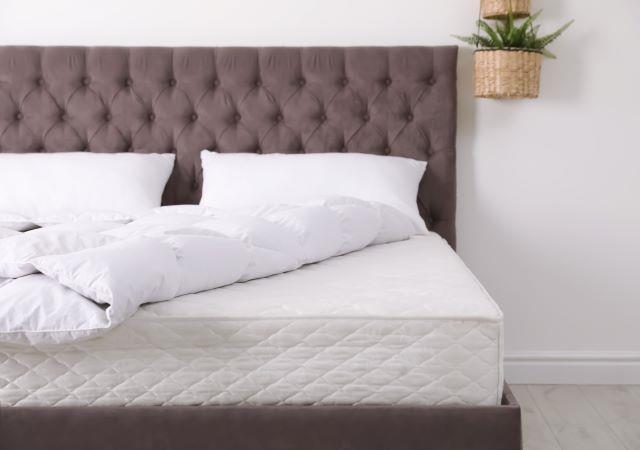Discovering mould on the surface of a mattress is unsettling, as it can be an indication of a much deeper problem within the core.

READ: Mattress care tips: how to deodorise and treat stains
Mould appears on a mattress if the conditions in and around the mattress are too warm and humid. If the mold is discovered quickly and treated properly, small colonies may be suitable for safe removal. However, the mold should be identified before attempting to treat the mattress.
1. The mould that most homeowners encounter can be classified into three categories: allergenic, pathogenic, and toxic.
2. Allergenic mould can require removal by a professional, but most allergenic moulds can be removed with home disinfecting products.
3. Pathogenic mould can be controlled with disinfectants but large colonies require professional removal.
4. Toxic mould is the most harmful and requires a professional to kill the mould and dispose of any affected materials.
READ: Get rid of mould without using harsh chemicals
According to the Centers for Disease Control and Prevention, mould can cause many side effects. For some people, mould can cause a stuffy nose, sore throat, coughing or wheezing, burning eyes, or skin rash. People with asthma or who are allergic to mould may have severe reactions. Immune-compromised people and people with chronic lung disease may get infections in their lungs from mould.
How Often to Clean a Mattress With Mould
When mould is discovered on a mattress, it should be cleaned away immediately, or the mattress should be disposed of following the guidelines of the local municipality. As long as there are spores present and the mattress is at an optimal temperature and humidity level, it will continue to grow.
What you will need
1. Equipment / Tools
2. Powerful hand-held vacuum
4. Floor vacuum with a hose and an upholstery brush attachment
5. Circulating fan
6. Protective eyewear
7. Protective mask
8. Rubber gloves
9. Air purifier
10. Microfiber cloth
11. Small bowl
READ: Buyers don't just accept a tick list. Disclosing that there is mould 'is not enough'
Materials
1. Phenolic disinfectant
2. Chlorine bleach
3. Pine oil disinfectant
4. Isopropyl alcohol
5. Disinfecting spray
6. Trash bag
Instructions
1. Wear Protective Gear and Improve Air Quality
To reduce your chances of an allergic reaction to the mould spores, wear eye protection, a mask, and rubber gloves. Wear clothing that can be tossed in the washer.
If possible, place an air purifier in the room to help capture mould spores that will become airborne.
2. Remove All Bedding
Remove all of the bedding, including the mattress protector, and wash them in the hottest water suitable for the fabric. Add a disinfectant—chlorine bleach, pine oil disinfectant, or phenolic disinfectant —that is safe to use on the fabric.
Dry the bedding at the highest heat appropriate for the fabric as a final step to be sure any mold spores have been eliminated.
3. Vacuum the Mattress
Use a powerful hand-held vacuum or a floor vacuum with a hose and upholstery brush. Start at one end of the mattress and vacuum the entire surface—even the areas with no visible mildew. Don't forget to vacuum the sides of the mattress.
If possible, turn the mattress over and inspect the other side for mould growth and repeat the vacuuming process.
When the vacuuming process is over, take the vacuum outside to reduce the chances of spreading the mould spores and empty the disposable bag or dust bin into a trash bag. Tightly seal the trash bag and dispose of it in an outdoor trash bin.
4. Treat the Mould Growth
The areas with mould growth must be cleaned with a product that will kill the spores. You should not saturate the mattress with an excessive amount of a wet solution because that can damage the mattress. The cleaners will not address any mold spores deep in the core of the mattress.
To kill mattress surface mold, mix a 50:50 solution of isopropyl (rubbing) alcohol and water. Dip a clean cloth into the solution and gently rub the mouldy surface of the mattress in a circular motion.
When the area is free of visible mould, dip a cloth in clean water and "rinse" the area.
5. Use a Fabric Sanitizing Spray
After cleaning and rinsing, spray the area with a fabric sanitizing spray like Febreze Fabric Antimicrobial that prevents mold growth on soft surfaces for up to 14 days.
6. Dry Thoroughly
Add a circulating fan or move the mattress into direct sunlight to help it dry as quickly and thoroughly as possible.
Source (The Spruce)
Want all the latest property news and curated hot property listings sent directly to your inbox? Register for Property24’s Hot Properties, Lifestyle and Weekly Property Trends newsletters or follow us on Twitter, Instagram or Facebook.








